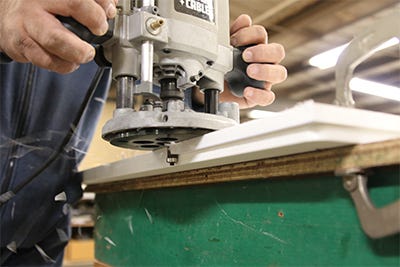HDPE Marine Board Starboard Sheets
HDPE marine board has become a backbone for various marine projects and applications due to its exceptional versatility and properties that make it an ideal choice for use in marine environments where exposure to water, salt, and sunlight quickly deteriorates other materials. Its resistance to moisture, lightweight, and superior insulation properties makes it an excellent choice for various boat components, from simple mounting plates to built-in cabinets. » Read More
High-density polyethylene
High-density polyethylene, commonly referred to as HDPE or by the brand name Starboard, has exceptional moisture resistance, which makes it good for replacing wood or metal. It will not rot or corrode when exposed to water, making it an ideal choice for use in harsh marine environments. Starboard, manufactured by King Plastics, mis a marine-specific HDPE product with added UV resistance and a durable, lightly textured atte surface for easy maintenance.
Most materials that boast these unique properties are either heavy, difficult to work with, or both; however, high-density polyethylene is a lightweight and versatile product, which is crucial in marine applications where weight can impact performance and fuel efficiency. Additionally, it offers excellent insulation properties, important for maintaining the temperature of the boat's components and for preventing condensation buildup.
The unique characteristics of this material make it an incredibly versatile and cost-effective material that has revolutionized the marine industry. It is perfect for a wide range of boat components, from small mounting plates to larger built-in cabinets. In the following sections, we will delve deeper into the benefits and applications of HDPE in the marine industry and provide tips on how to work with and maintain these sheets for long-lasting performance.
What Is High-Density Polyethylene & How Is It Made?
HDPE marine board is produced by some of the most advanced manufacturing processes which results in remarkable polyethylene plastic sheet material with exceptional durability and performance. They process high-density polyethylene, a thermoplastic polymer, using specialized methods to create a marine-grade material that resists moisture, UV radiation, and other harsh marine conditions. The advanced manufacturing process produces a material with superior strength, excellent dimensional stability, and long-lasting performance that exceeds that of other plastic materials.
Low-Density Polyethylene (LDPE) may sound like HDPE, but the two couldn’t be more different. LDPE, or low-density polyethylene, has a more branched and less tightly packed structure, making it more flexible and lightweight, and is great for uses that require significant flexibility and softness (e.g. water bottles, molded plastic equipment, and plastic bags).
Due to its unique properties, this marine board has become a popular choice in a wide range of marine applications. It is lightweight, easy to handle and install, and highly resistant to moisture and UV radiation, making it ideal for harsh marine environments where exposure to the elements can cause other materials to deteriorate quickly. Moreover, the material is available in various sizes, thicknesses, and colors, making it customizable for different marine applications, such as cutting boards, cabinetry, seating, hatches, and more.
How to Work With HDPE
Although HDPE is versatile and easy to work with, it is essential to keep some important considerations in mind. When working with HDPE, it is crucial to use the right tools. Common woodworking tools are usually sufficient, but it is important to use sharp blades and bits.
Additionally, it is essential to work with HDPE in a well-ventilated area and wear protective gear such as safety glasses and gloves to prevent injuries. To ensure clean cuts, it is important to use a straight edge when cutting this type of board. Be careful not to apply too much pressure to the material.
Boat Outfitters has created an authoritative, free guide to working with high-density polyethylene marine board. For more details on tools and techniques, download the guide.


Does Starboard Discolor in Sunlight?
One common question that people have is whether or not it will discolor in sunlight. While some types of HDPE may discolor over time, this is not such a big issue with marine board. High-density polyethylene marine board is specifically designed to be resistant to UV radiation, which means that it is resistant to fading or discoloring even with prolonged exposure to sunlight.
Things to Keep in Mind When Working With High-Density Polyethylene Marine Board
While this marine board is a durable and versatile material, there are some factors to consider when working with it to prevent potential issues. Here are some important aspects to keep in mind:
- Expansion and contraction: It can expand and contract due to temperature changes. If you plan to use it in areas with large temperature swings, proper allowance for expansion and contraction is necessary to prevent warping or buckling.
- Cutting and drilling: It is relatively soft and can melt or chip if not cut or drilled properly. Using sharp tools and a slow cutting speed is essential to avoid such issues.
- Adhesives: Glues, sealants, and other adhesives do not work well with this board. Some bonding can be achieved with specialized glues and techniques, but adhesives should never be used in place of mechanical bonding.
- Cleaning: Although easy to clean, this board needs the right kind of cleaning agent. Abrasive cleaners or harsh chemicals can cause scratches or damage to the surface.
By considering these factors, you can ensure that your marine board project will be a success.
Benefits of HDPE Marine Board
There are many benefits to using high-density polyethylene marine board for your boat components:
- Cost-effective material, making it an excellent choice for those who want to keep their costs low without sacrificing quality.
- It is lightweight, which makes it easy to transport and install.
- It also has excellent insulation properties, making it ideal for use in areas where temperature control is essential.
- Also resistant to moisture and chemicals, meaning it will last for years to come.
- It is durable. It is resistant to impacts and abrasions, making it a reliable choice for boat components.
- It is also a low-maintenance material. Unlike other materials, it does not require regular sanding, compounding, polishing, painting, or sealing to maintain its appearance and functionality, saving time and money on maintenance costs.
- Sustainable and eco-friendly choice, as it can be recycled and reused. This means that it not only saves you money in the long run, but it also helps to reduce waste and promote a healthier environment.
This marine board is a very versatile and reliable material that can help add longevity and trust in your boat projects.
Cleaning & Maintenance
This marine board is a durable and long-lasting material that can withstand harsh marine environments. However, it still requires proper cleaning and maintenance to keep it looking its best and functioning as intended.
To clean HDPE, it is recommended to use a cleaner like Soft Scrub and a stiff brush for routine cleaning. Avoid using turpentine, MEK, or naphtha. It is important to rinse the board thoroughly with fresh water after cleaning to remove any soap residue. For more stubborn stains, try household bleach or pressure washing. A Magic Eraser can also be used to remove stains. As a last resort, you can lightly sand the stained area.
HDPE is a cost-effective material that is perfect for a wide range of marine applications. It provides impressive durability, good insulation properties, and can endure harsh marine environments without degrading. Whether you require boat components, dock fenders, or outdoor furniture, HDPE is a versatile material that can satisfy your needs. When choosing a supplier for your HDPE Marine Board, it is important to consider factors such as price, quality, and customer service.
HDPE board material can be a reliable and versatile material for both DIY enthusiasts and professional boat builders. Its durability can help ensure longevity and trust in your projects. With the right care and maintenance, it can withstand harsh marine environments for many years, allowing it to continue to perform well over time.
Need More Help Deciding? Give us a call!
For the last 40+ years, we’ve perfected the art of upgrading boats and helping boaters better enjoy their time on the water. If you have a question about a product or project give us a call! Our team of experts is here to help!

Need Help?
Speak to one of our industry pros:
Tap to Call
